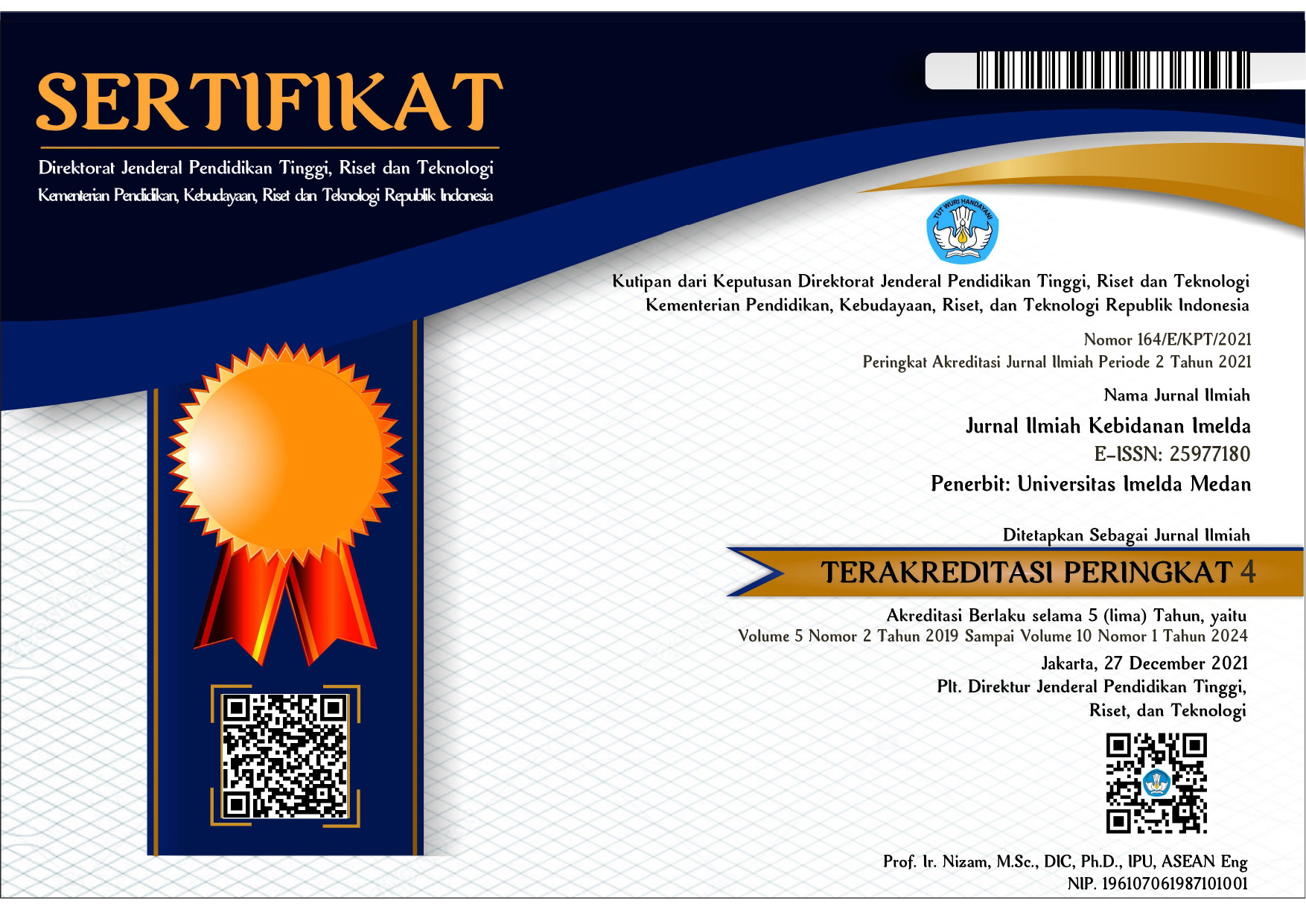PENGARUH PENERAPAN MODEL PELAYANAN MATERNITAS PENDAMPINGAN ONE STUDENT ONE CLIENT (OSOC) TERHADAP TINGKAT KECEMASAN PADA IBU DALAM MASA POSTPARTUM DI RS PERMATA HATI KISARAN TAHUN 2022
DOI:
https://doi.org/10.52943/jikebi.v10i1.1244Keywords:
Worry, Post Partum, One Student One Client (OSOC)Abstract
Psychological problems experienced by mothers giving birth in hospitals really need optimal attention and care. The psychological changes experienced by postpartum mothers can be caused by the adjustment phase of the mother towards her role as a parent. After giving birth, mothers really need support and motivation to support all activities and new roles. So that postpartum mothers need more attention from the family, the people around them, especially from their husbands. At this time the mother really needs attention, understanding and affection that is more specific otherwise there will be coping failure in the postpartum mother which results in anxiety during the postpartum period. The aim of the research is to analyze the effect of implementing the One Student One Client (OSOC) maternity service model on maternal anxiety levels in the postpartum period at Permata Hati Kisaran Hospital in 2022. Quasi-experimental research with a non-equivalent control group design. The subjects of this study were 80 postpartum mothers divided into 2 groups into the intervention group and the control group. In the intervention group, intervention was given in the form of providing OSOC assistance during the postpartum period, while the control group was given conventional postpartum care. The results showed that there was an effect of applying the OSOC model to a decrease in anxiety in postpartum mothers with a probability of 7.429 times not feeling anxiety compared to those who were not accompanied. The results of data analysis revealed that the OSOC intervention group had an effect on the anxiety level of postpartum mothers with an asymp value. Sig 0.000 (< 0.05). Referring to the results of data analysis and research findings, it can be concluded that the effect of applying the OSOC maternity service model has an effect on the anxiety level of mothers in the postpartum period.
References
R. dan S. Ahsan, Lestari, “Faktor-Faktor yang Mempengaruhi Kecemasan Pre Operasi Pada Pasien Sectio Caesarea di RSuang Instalasi Bedah Sentral RSUD Kanjuruhan Kepanjen Kabupaten Malang,” J. Keperawatan, 8(1), pp. 1–12.
G. C. CARRIGAN CP, KWASKY AN, “Social support postpartum depression And professional assistance: A survey of mother sinthe Midwestern United States.,” J. Perinat. Educ. 24(1) 48-60, 2015.
Y. KIRANA, “Hubungan Tingkat Kecemasan Postpartum dengan Kejadian Postpartum Blues di Rumah Sakit Dustira Cimahi.,” J. Keperawatan BSI, 2015.
dkk. et al. Ai Yeyeh, Rukiyah, “Asuhan Kebidanan 1. Jakarta: CV. Trans Info Media.”
Yanti, “Students’ understanding of ‘Women-Centred Care Philosophy’ in midwifery care through Continuity of Care (CoC) learning model: a quasi-experimental study. BMC Nurs. 14, 22. doi:10.1186/s12912-015-0072-z.”
S. Chuntharapat, “The Effect of Using a Yoga Program during Pregnancy on Maternal Comfort, Labor Pain, and Birth Outcome. Doctor of Philosophy in Nursing, Prince of Songkla University,” 2007.
Rozikhan1 Titik Sapartinah 2, “PERBEDAAN TINGKAT KECEMASAN IBU HAMIL PRIMIGRAVIDA DENGAN MULTIGRAVIDA DI ERA PANDEMI COVID-19 DI WILAYAH KABUPATEN KENDAL,” Midwifery Care J., vol. 2, no. 1, pp. 15–20, 2021.
Aslinda H., “Hubungan Kejadian Pandemi Covid-19 dengan Kecemasan Ibu hamil Trimester 3,” 2021.
C. Dede Yoshima Nekada, T. Aquino Erjinyuare Amigo, P. Deni Krisnanto, U. Respati Yogyakarta Program Studi Keperawatan, and F. Ilmu Kesehatan, “Keep Working in A State of Anxiety About Covid-19 Pandemic,” pp. 158–165, 2020.
E. Tursilowati, S.Y., dan Sulistyorini, “Pengaruh peran serta suami terhadap tingkat kecemasan Ibu hamil dalam menghadapi proses persalinan di Desa Jepat Lor Kecamatan Tayu Kabupaten Pati.,” J. Kesehat. Surya Med. Yogyakarta, Hal 1-17., 2017.
F. Fastabiq SH, “Pengaruh Program OSOC (One Student One Client) Terhadap Pengetahuan Dan Keterampilan Mahasiswa Bidan Dalam Memberikan Asuhan Kebidanan; Universitas Aisyiyah Yogyakarta, Tesis,” 2016.










